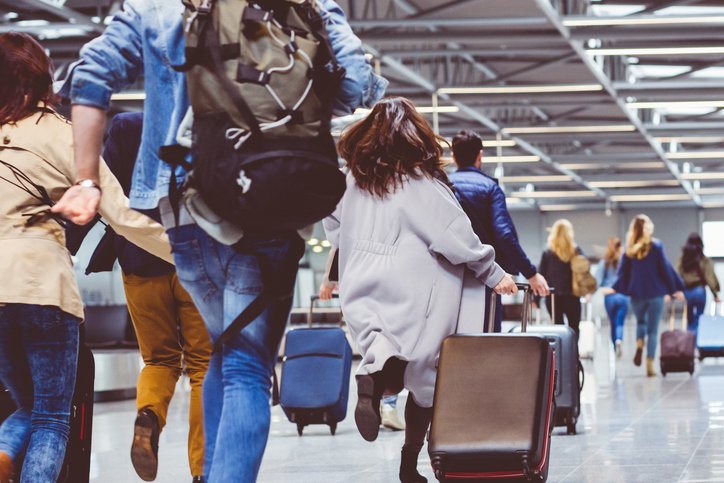A risky TikTok trend called “Airport theory” has racked up 400 million views and left many travelers missing their flights. People try to speed through airports in record time, with some TikTokers bragging about 15-minute rushes to their gates. Searches on Google for “I missed my flight what do I do” jumped 70 percent in the last month.
Most airlines suggest arriving two hours before domestic flights and three hours for international trips. The national average security wait stretches to 27 minutes, and major airports like JFK and Chicago O’Hare see delays up to 40 minutes. This complete guide gets into why this trending airport strategy creates more problems than solutions, and what travelers should know before trying this dangerous shortcut.
What is Airport Theory and Why is it Trending on TikTok?

Image Source: The Spectator
“Airport theory” challenges the standard travel wisdom that tells travelers to arrive hours before their flight. This bold approach suggests passengers should arrive just 15-20 minutes before boarding time instead of the usual 1-2 hours for domestic and 2-3 hours for international flights.
The 15-minute airport arrival challenge
The basic contours are bold yet simple: travelers with online check-in and hand luggage try to reach their boarding gate from the airport entrance in under 15 minutes. Supporters say this is the quickest way to “limit passengers’ wasted time by streamlining the airport experience”. The strategy helps travelers avoid spending money at expensive airport shops and restaurants. This approach naturally appeals to spontaneous people who hate airport waiting – they can spend more time at home or on vacation rather than sitting idly at gates.
How the trend gained 400 million views
Social media users became fascinated by airport theory videos during peak travel times, especially during spring break season. Google searches for “airport theory” hit record highs for two straight months. Searches for “I missed my flight” shot up by 645%. The trend’s controversial nature drives its popularity worldwide, with people either “fully embracing” it or dismissing it as a “reckless attempt to justify poor time management skills”.
Notable TikTok creators behind the movement
Michael DiCostanzo stands as a pioneer of this movement. He put the theory to test at Hartsfield-Jackson Atlanta International Airport—one of the world’s busiest terminals. Security took just seven and a half minutes and he reached his gate in under 15 minutes total, calling it “a huge win for airport theory”. Lexi Smith achieved similar success at LAX, clearing security in five minutes despite being “randomly selected for an additional security screening”.
Success stories don’t tell the whole story. Jenny Kurtz’s experiment failed when she saw “flight closed” flashing on terminal screens at her Chicago gate. Her TikTok video now serves as a warning: “For those of you thinking about testing out the airport theory, don’t do it”.
Medical professionals have jumped on the trend too. Neurosurgeon Betsy Grunch, who has 2.4 million TikTok followers, documented her 18-minute rush through Atlanta’s airport after arriving 26 minutes before boarding. Content creator James Shaw took a more measured approach and recorded his family’s 13-minute walk through Tampa International Airport after arriving 90 minutes early.
The Psychology Behind Risky Airport Behavior

Image Source: International Airport Review
The airport theory trend might seem reckless, but fascinating psychological factors explain why people choose to risk missing their flights. People find cutting it close at airports strangely appealing due to specific mindsets.
The thrill-seeking element
The main reason airport theory practitioners do this is the adrenaline rush. Neurosurgeon Betsy Grunch showed her 18-minute airport sprint and called it “fun.” She admitted she’s “fueled by adrenaline” and “super-competitive”. This feeling matches what psychologist Steve Taylor compares to the thrill of “catching a wave properly” – you need perfect timing or risk being “wiped out” if you get it wrong.
These travelers actually make this time pressure happen on purpose. A frequent flyer told The Atlantic, “I just really live for the feeling of literally running through the airport barefoot because you didn’t have time to put your shoes on after security”. Psychiatrist Jonny Gerkin suggests this behavior shows a different way to handle anxiety – instead of planning ahead, people “distract and procrastinate” until the excitement takes over their worries.
Main character syndrome at the terminal
The airport brings out what TikTokers call “main character syndrome” – that feeling you’re starring in your own movie. A TikToker captured this by filming themselves looking thoughtful around the airport. Another traveler said “when I’m stomping down to gate 56 with my carry-on wheeling behind me, the terminal becomes my catwalk”.
Airports work as “liminal zones where boundaries fade”. Travelers enter a psychological no-man’s-land between countries and time zones after security. This creates a sense of disorientation that lets people break free from normal social rules.
Content creation vs. ground consequences
The thrill and movie-like appeal of airport theory comes with real effects. Searches for “I missed my flight” jumped 645% after the trend got popular. So many creators now show their failed attempts, like Jenny Kurtz’s video that shows terminal screens flashing “flight closed” with her warning: “I would not recommend”.
Why Airport Theory Fails: Real Stories of Missed Flights

Image Source: Simple Flying
Viral airport theory videos have left countless passengers stranded across the country. Many learned their lesson the hard way – 15 minutes is nowhere near enough time to catch a flight.
Statistical spike in missed flights
Google searches for “I missed my flight what do I do” have jumped 60% in the last month alone. Other platforms show an even more dramatic 70% increase in similar searches. The numbers tell a clear story – since airport theory became trendy, Google searches for “I missed my flight” have exploded by 645%. A warning video by TikTok user Jenny Kurtz has racked up 15.8 million views, which shows just how many travelers are watching—and often ignoring—these warnings.
Financial costs of rebooking last-minute
Missing a flight because of this trend can hit your wallet hard. Airlines often require passengers to buy completely new tickets if they can’t help with rebooking. Many airlines have a “flat-tire rule” that lets you book the next available flight, but this only works for real emergencies—not TikTok challenges. Routes with few daily flights might leave passengers stuck for days waiting for an open seat. It gets worse when you miss your first flight – airlines typically cancel your entire round-trip itinerary, which doubles the financial pain.
Emotional toll of travel disruption
The cost goes way beyond money when flights are missed. Travelers heading to one-time events like weddings or funerals lose moments they can never get back. The stress shows up as anxiety, frustration, and anger. Half of all passengers deal with anxiety from flight delays that leads to health issues. Families face even bigger hurdles since getting everyone rebooked multiplies the stress. Airport staff feel the strain too as they deal with more frustrated passengers rushing through security at the last second.
This airport theory trend shows how content creation has taken priority over practical travel advice—it’s a viral challenge where the risks are just not worth those few minutes saved.
Airport Operations: What Happens When You Cut It Close

Image Source: CNA
Airport operational systems run on precise timelines that leave no room for late arrivals. Many passengers who try “airport theory” don’t understand these crucial behind-the-scenes realities.
How boarding gates actually work
A gate does more than just lead to your plane. Each one links to a specific parking spot on the airport’s apron and controls passenger access. Atlanta’s Hartsfield International staff processes about 250,000 passengers and 2,500 flights daily. Airlines stop boarding exactly 15 minutes before takeoff to complete safety checks and brief passengers. The crew creates a final manifest after boarding ends to record all passengers officially. International flights use special doorways that connect to separate corridors leading straight to customs.
Why even the smallest airport in the world needs buffer time
Buffer time plays a vital role at regional airports too. This extra cushion helps handle unexpected delays without disrupting the entire schedule. Airlines add this time strategically because small disruptions can create expensive ripple effects throughout the day. Swedavia airport’s automated boarding gates work 20-30 times faster than traditional methods. Yet buffer time remains essential.
What airline staff think about the trend
Flight attendants have a surprising take on the airport theory trend. Empty seats from missed flights give airline employees a chance to use their flight benefits. Internal reports show this has become a “godsend for flight attendants and other airline employees who are desperately trying to use their flight benefits to fly somewhere for next to nothing”. Staff at major hubs like Chicago O’Hare “eager to take your seat off you” if your airport theory gamble fails.
Social media trends promise clever life hacks, but airport theory shows why viral advice isn’t always worth trying. People racing through terminals might create engaging content. The stark 645% increase in missed flight searches reveals the potential risks of this risky approach.
A successful airport experience depends on understanding simple operational realities. Airlines don’t randomly choose their check-in and boarding windows. They use careful calculations to create buffer periods that protect travelers and airlines from disruptions that get pricey and affect the whole system.
Time definitely matters for air travel. Trying to compress airport procedures into 15 minutes remains dangerously optimistic. Smart travelers know early arrival gives them valuable protection against unpredictable factors. Security delays, terminal navigation challenges, and unexpected documentation requirements can throw off even the best-laid plans.
The quickest way to plan ahead beats testing airport theory any day. Travelers who complete online check-in, download boarding passes, and organize their documents beforehand enjoy a smooth airport experience. This approach helps them avoid missed flights and substantial rebooking fees.






